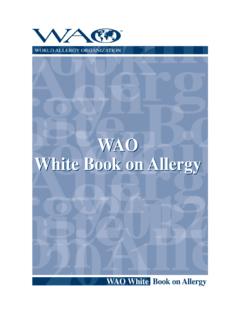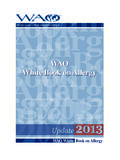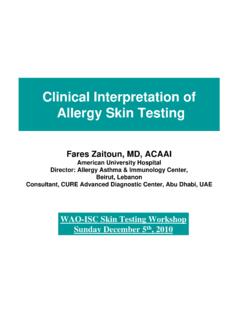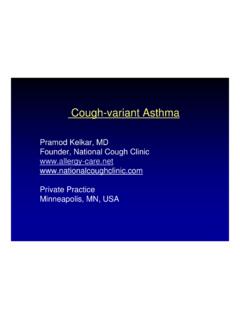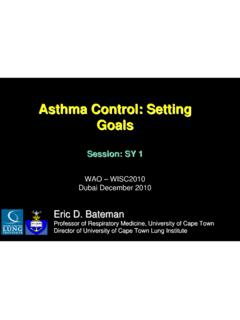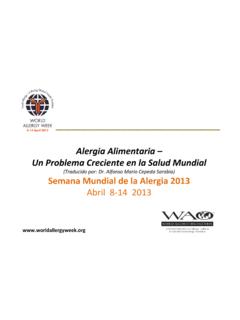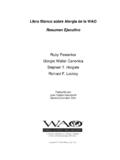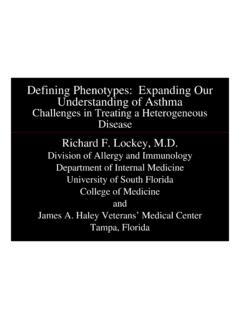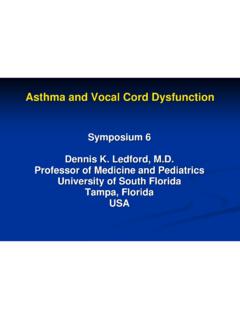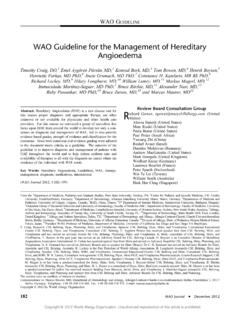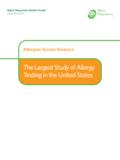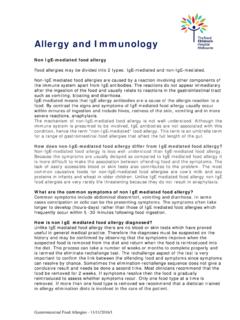Transcription of Spirometry Overview - World Allergy Organization
1 Spirometry OverviewSpirometry OverviewThomas B Casale, MDProfessor and Chief, Allergy /ImmunologyCreighton UniversityOmaha, NE USAF aculty Disclosure I have no financial interests/arrangements that would be considered a conflict of Objectives To define what constitutes accurate and adequate spirometric assessment To discuss how Spirometry performance and interpretation differ depending on age To review how pulmonary function assessment compares with other outcome measures in asthmaCourse OutlineATS/ERS TASK FORCE: STANDARDISATION OF LUNG FUNCTION Miller, J. Hankinson, V. Brusasco, F. Burgos, et al. Standardisation of Spirometry . Eur Respir J 2005; 26: 319 338R. Pellegrino, G. Viegi, V. Brusasco, Crapo, et al. Interpretative strategies for lung function tests.
2 Eur Respir J 2005; 26: 948 For SpirometryEquipment Quality ControlClosed Circuit ManeuverSpirometry Values FVC: Forced vital capacity: the volume of air that can be maximally forcefully exhaled. FEV6can be used as a measurement of FVC in adults FEV1: Forced expiratory volume in one second (best measure of assessing airway obstruction) FEV1/FVC: ratio expressed as a percentage (low values c/w obstructive lung disease) FEF25-75: The average forced expiratory flow during the mid (25 - 75%) portion of the FVC PEF: (FEFmax) Peak expiratory flow (liters/second) rate during expiration (peak flow meter measurements are in L/min)ReproducibilityCriteriaApplication Of Reproducibility AndAcceptabilityCriteriaPercent Predicted Variables Gender: Males > Females Age: Its downhill after 20-25 Height: The taller the Larger Ethnicity Matters.
3 Caucasians > Blacks and Indians > Chinese > PolynesiansFEV1 Plateau of lung function between the ages of 20 and 30then FEV1 falls approximately 20-30 mL per year. Smokers lose about 60 mL per yearMen WomenSpirometry Flow/volume curve Spirogram: Vol / timeSpirogramThe normal volume time curve has a rapid upslope and approaches a plateau soon after exhalation. volume (FEV1).Normally the volume exhaled in one second is approximately 80% of the total volume, while the volume after 3 seconds is equal to the FVCFlow Volume LoopsFlow is plotted against volume to display a continuous loop from inspiration to expiration. The overall shape of the flow volume loop is important in interpreting spirometric results.
4 Flow Volume loopEffort DependentEffort IndependentThe Value Of FEV1 For Obstructive Lung Disease: Severity ClassificationGOLD: COPDNIH: AsthmaATS/ERS Severity: FEV1 Forced Vital Capacity (FVC) Full inspiration to TLC Rapid, forceful maximum expiration to RV Effort dependent Differs from Slow Vital Capacity Slow VC may be greater with obstruction Normal > 80% Generally = FEV6 FVCFlowVolume (liters)Younger OlderNormal Patterns: Age MattersFEV1/FVCS ears M at al, N Engl J Med 2003;349 > 70 y/o healthy nonsmokersHardie JA at al, Eur Respir J 2002; 20: 1117 1122 FEV1/FVCNIH asthma guidelines 2007 FEF 25-75% Mean forced expiratory flow rate between 25% and 75% of the expired vital capacity Rate of air flow during the middle of the test midflows MMEF (maximum midexpiratory flow) Reflects air flow in the peripheral or small airways Less sensitive and specific Largely effort independent Normal > 50%FEF 25-75 Abnormalities are not specific for small airway disease and, though suggestive, should not be used to diagnose small airway disease in individual patients.
5 Am Rev Respir Dis 1991; 144:1202-1218 PEF Peak expiratory flow (L/sec) Or FEFmax Measurement of FLOW not volume Effort dependent Measured in L/sec Handheld peak flow meter measured in L/min: PEFRPeak Expiratory FlowFlowVolume (liters) Spirometry should be interpreted using the flow volume and volume time curvesas well as the absolute values for flows and volumes. InterpretationNormalFlow Volume Loop Normal PatternsNormal Varient knee Obstructive patternShape of flow volume loop is relatively unaffected in restrictive disease: overall size of the curve will appear smaller when compared to normals. rapid upslope on the volume time curve, but such patients will reach a smaller vital capacity. Restrictive lung disease cannot be diagnosed by Spirometry alone.
6 Restrictive DiseaseObstructiveRestrictiveFVCnormal FEV1 FEV1/FVC %FEF 25-75normalFRCnormalRVnormalTLCnormalObs tructive vs RestrictiveReversibility: ATS/ERS Task Force Four separate doses of 100 mcg should be used when given by MDI using a spacer. Tests should be repeated after a 15-min delay An increase in FEV1 and/or FVC 12% of control and 200 mL constitutes + bronchodilator response Increments of <8% (or <150 mL) are likely to be within measurement variabilityUnacceptable Patterns/ ManeuversSlow startDid not exert maximal effortMay be lack of effort but may be normal if reproducible in young femalesCalled rainbow curve Unacceptable Patterns / ManeuversEffort ended earlyFalsely decreases FVCF alsely increases FEF 25-75 Stopped exhaling momentarilyFlow Volume Loop PatternsCoughing Sawtooth patternUpper airway muscle weakness, Classic for OSAO ffice Spirometry When office Spirometry shows severe abnormalities, or if questions arise regarding test accuracy or interpretation, further assessment should be performed in a specialized pulmonary function laboratory.
7
